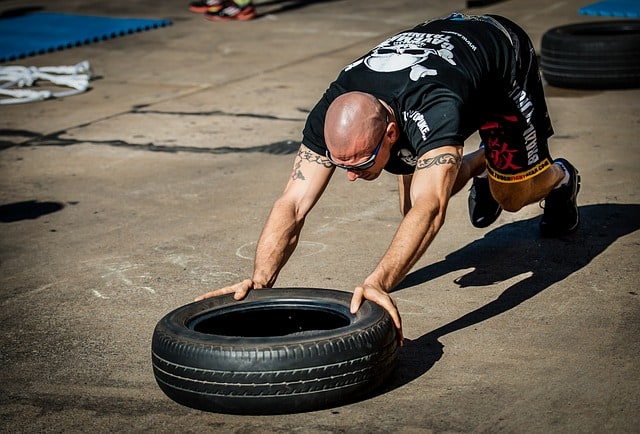Kinetic and Potential Energy: Examples and Differences Between Both of Them

In Physics, energy is used to refer to an ability to do work. Energy exists in various forms. This includes Gravitational energy, Chemical energy, Radiant energy, Mechanical energy, Sonic energy, Thermal energy, Nuclear or atomic energy, Magnetic energy and Electrical energy amongst many others. These types of energy can be converted from one form to the other. In Physics, energy is measured in Joules.
Mechanical energy is a form of energy a body possesses by virtue of its position (rest) or motion. There are two major types of mechanical energy. They are
- Kinetic energy
- Potential energy
What is Kinetic Energy?
The word ‘kinetic’ stems from the Greek word ‘Kinesis’ which means ‘motion’. This is the type of energy possessed by an object by virtue of its motion. Thus, an object at rest is said to possess zero kinetic energy. It can be defined as the amount of work needed to accelerate a body of a certain mass from rest to a stated velocity. More often than not, kinetic energy can be transferred from one object to another.
This is because, when an object which has possessed kinetic energy by virtue of its being in motion hits another object, which is stationary (in this case said to possess potential energy), the object at rest receives part of the energy inherent in the body which has kinetic energy and expresses the received energy in the form of motion or in some forms different from the initial stationary position. This is exemplified by the collision of pool balls in a game of snooker.
Kinetic energy depends on the mass and velocity of the body in motion, with the velocity contributing more to the overall kinetic energy of the body. Thus, the higher the mass and velocity of a body, the greater the kinetic energy attained.
Kinetic Energy (K.E) = (½)mv2
m= Mass in Kilograms
v= Velocity in ms-1
However, unlike acceleration, momentum, and velocity, kinetic energy is a scalar quantity. This means that kinetic energy cannot be completely described in terms of the direction of the energy but can only be completely described in terms of its magnitude.
Few Examples of Kinetic Energy
The following are typical examples of kinetic energy:
- A wrecking ball used to demolish a building through utilization of the kinetic energy it possesses in motion.
- Conversion of liquid water to steam, by virtue of the fast movement of the molecules of the liquid upon agitation
- A golf ball after being struck off the tee
- An asteroid falling towards Earth at incredible speed
- A downhill skier traveling down a hill
- The flow of a river
- An airplane in motion (possesses a tremendous amount of kinetic energy. This is because the mass of the airplane and the velocity at which it moves are enormous)
What is Potential Energy?
Potential energy is a type of mechanical energy possessed by a body at rest. It is a result of the overcoming internal forces within an object relative to the various agitating external forces. In Physics, potential energy (PE) is said to be equal to a product of mass (m) in Kilograms, Acceleration due to gravity (g) in m/s2 and height (h) in metres.
That is Potential Energy (P.E) = mgh.
This type of energy is present in every object which has a mass and position within a force field and has a kinetic energy of zero relative to other objects. There are various forms of potential energy. This includes Elastic potential energy, Nuclear energy, Chemical energy, Gravitational potential energy, and Electric potential energy.
However, it must be noted that there is usually a rapid conversion of energy from potential to kinetic when an object which originally possessed potential energy is set in motion, which consequently causes a change in position of the object.
Few Examples of Potential Energy
- Potential energy is stored in a stretched rubber band e.g in a catapult, where it provides the energy needed to propel the stone from rest.
- The muscle of an archer who is set to fire an arrow from the bow has stored potential energy.
- Potential energy is stored in the wound up string of a toy car as elastic potential energy, this provides the energy needed to move the toy car from its initial rest position.
- A stone lifted to a certain height possesses potential energy.
- Chemical energy, a form of potential energy produced during chemical reactions is stored in batteries, food, fuels such as Petroleum, Coal and Natural gas. Thus, electric cells supply electrical energy as a result of chemical reactions within the cells and food ingested by animals undergo various metabolic reactions to yield muscular energy and heat.
Differences Between Kinetic Energy and Potential Energy
Although kinetic energy and potential energy are both types of mechanical energy, many differences exist between them. Some of these differences are quite obvious; others are not. These differences are illustrated below:
| S/N | Kinetic energy | Potential energy |
| 1. | Can be transferred between objects | Cannot be transferred from one object to another |
| 2. | Is dependent on the mass and velocity of an object but, does not depend on the height | Depends on the mass, acceleration due to gravity and height of an object, but does not depend on the velocity. |
| 3. | Kinetic energy refers to the energy present in the object due to the motion of a body | Potential energy refers to the energy present in an object due to its position |
| 4. | K.E = (1/2)mv2 where m is mass and v is speed | P.E = mgh where m is mass, g is gravity and h is height. |
| 5. | It is relative to other moving and stationary objects within the immediate environment of a body | It is not relative to the environment of an object |
| 6. | It is exemplified by the fall of water in a waterfall | Exemplified by water at the top of a waterfall before the precipice |
The key difference that exists between kinetic energy and potential energy lies in the fact that, potential energy is that form of mechanical energy which is stored within an object, ready to be released as and when needed to do some work, while, kinetic energy is that form of mechanical energy that has been released and is associated with the body in motion.
Also, the kinetic energy of a body is expected to increase tremendously as the velocity of the body increases. This is because; the Kinetic energy (K.E) is directly proportional to the square of the body’s velocity (v2). The mass of the body also contributes directly to the kinetic energy of a body due to the direct proportionality that exists between K.E and mass as exemplified by the Kinetic energy equation (K.E) = (1/2)mv2 as earlier mentioned.
In addition, the potential energy of a body increases with an increase in height and mass of the body. This is also due to the directly proportional relationship that exists between Potential energy and a body’s mass and height as illustrated by the equation P.E = mgh, where ‘g’ is 9.8ms-2, a constant.
In conclusion, all objects possess one form of mechanical energy or the other by virtue of rest or position. The energy possessed – kinetic or potential, goes a long way in defining which parameters influence the amount of energy possessed by the body and consequently affects the amount of work it would be able to do.
Sources:
- What is Kinetic energy? Retrieved from: https://www.khanacademy.org/science/ap-physics-1/ap-work-and-energy/kinetic-energy-ap/a/what-is-kinetic-energy
- Types of potential energy. Retrieved from: https://www.physics-and-radio-electronics.com/physics/energy/potential-energy/types-of-potential-energy.html





